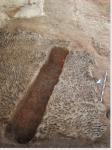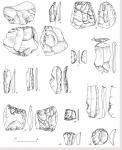Summary (English)
EXPLORATIONS NEAR SOZOPOL (Miroslav Klasnakov – miro_klasnakov@abv.bg, Petar Leshtakov) The Late Neolithic stratum was 20 – 45 cm thick. A burned house, 10.80 m by 12.95 m in size and cut by five vineyard trenches of the Roman period, was explored within the stratum. Twelve ovens with U-shaped and rectangular layouts were explored. Four piles of debris, probably originating from burned houses, six piles of sherds, charcoal and animal bones and two piles of stones were discovered. Thirty-two pits were explored, containing sherds, fragments fro terracotta anthropomorphic figurines, flint artifacts (cores, retouched plates, combined tools, scrapers), stone tools (adzes, axes, pestles), horn and bone tools, querns, animal bones and small pieces of charcoal. The pottery included dishes, bowls, jugs, pots, etc., which were synchronous to the end of Karanovo III and Karanovo IV. The osteological analysis of the animal bones discovered from 2008 to 2010 found the presence of auroch, deer, red deer, fallow deer, boar, fox, wild cat, bear, rabbit, Mediterranean monk seal, dolphin, fishes, birds, ox, sheep, goat, pig and dog. The bones from domestic animals prevailed. Sherds from black-gloss pelike and lekane of the second half of the 4th – 3rd century BC were found, probably related to the necropolis of Apollonia. Part of a stone quarry of the second half of the 4th – 3rd century BC, 13 m by 8 m in size, was explored. Three ashlars, still not cut out from the rock, were documented. The finds included sherds from a black-gloss kylix, a pyxis and an oinochoe. Sixty-six vineyards trenches of the 2nd – 4th centuries AD were documented. They were 1 – 19.40 m long, 0.35 – 1.95 m wide and 15 – 80 cm deep. The finds included sherds, including from amphorae and dolia, buildings ceramics and a fragment from glass vessel.
- Miroslav Klasnakov - Regional Museum – Burgas
- Petar Leshtakov - Archaeological Institute with Museum
Director
Team
Research Body
- Archaeological Institute with Museum
- Regional Museum – Burgas






![Download [PDF]](/excavation/skins/fasti/images/results/download_sml.png)

